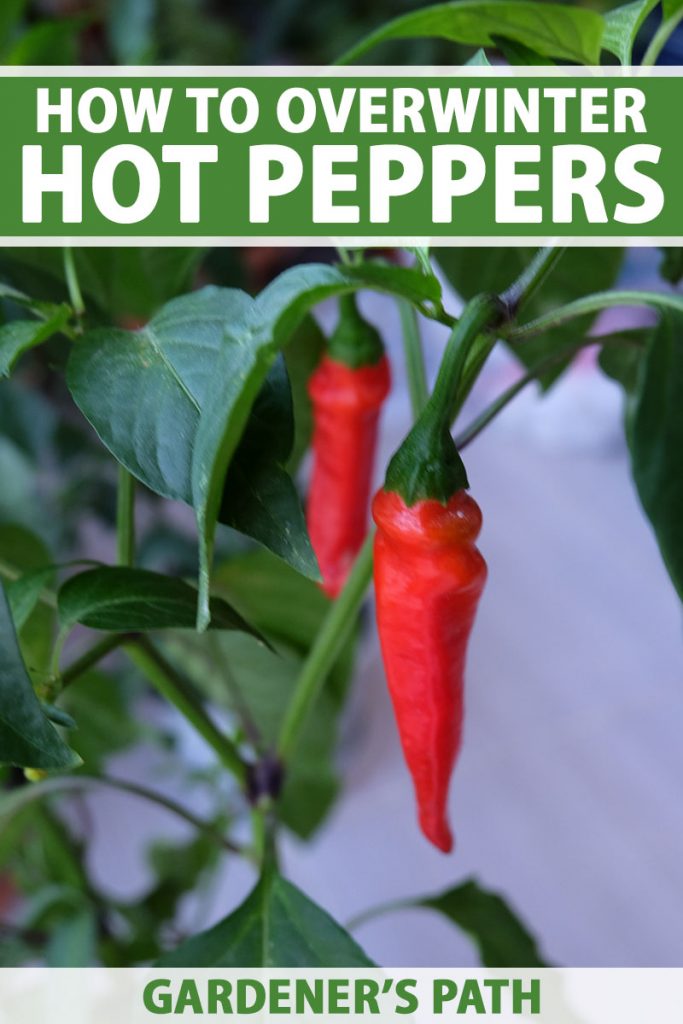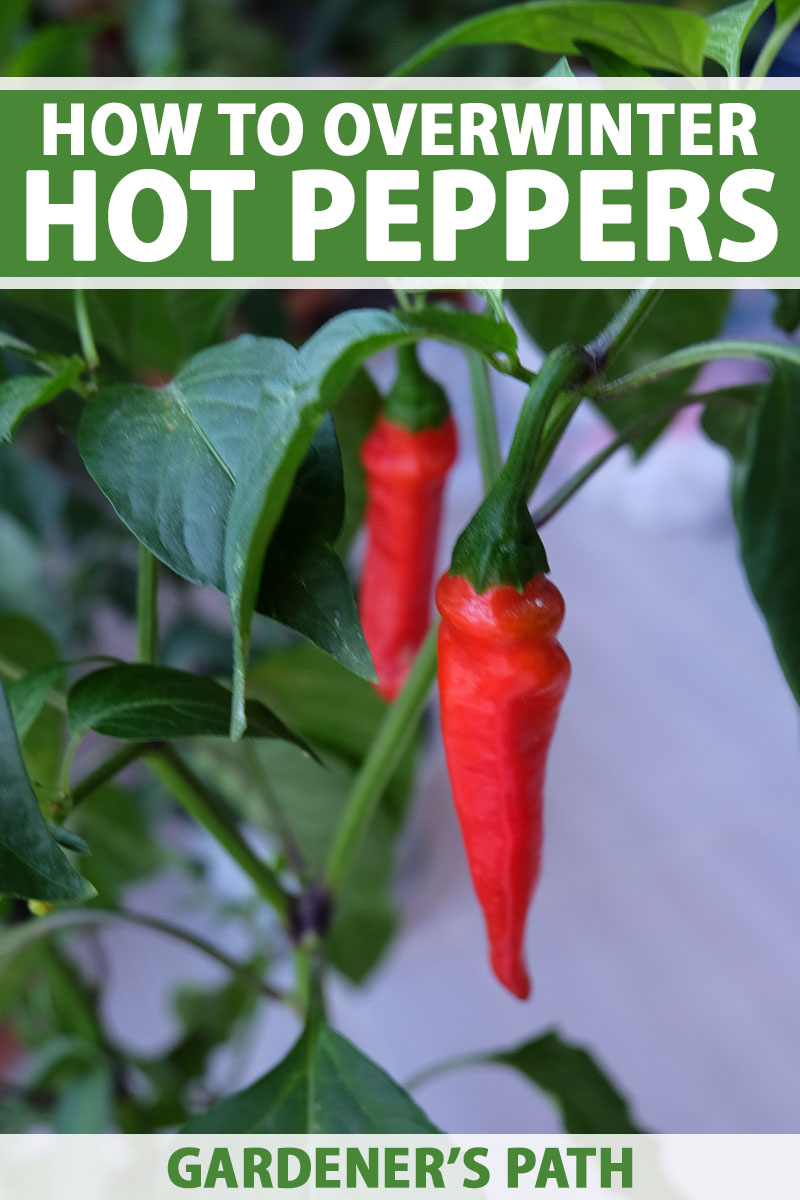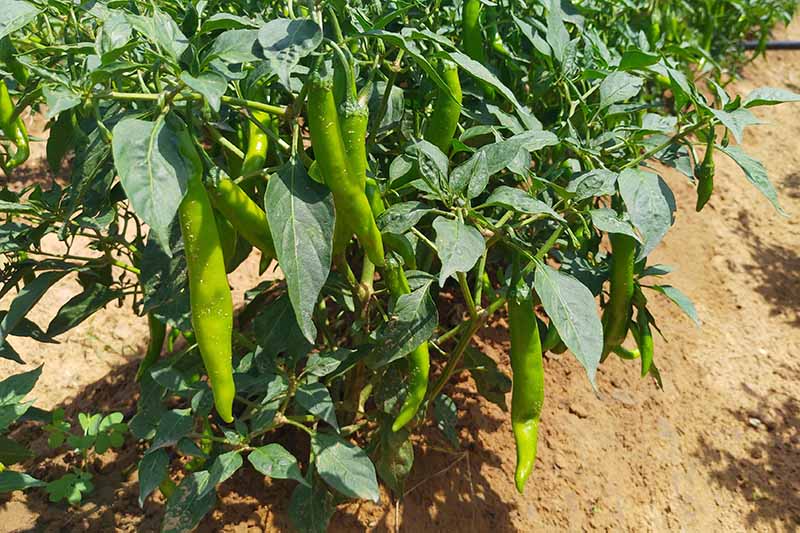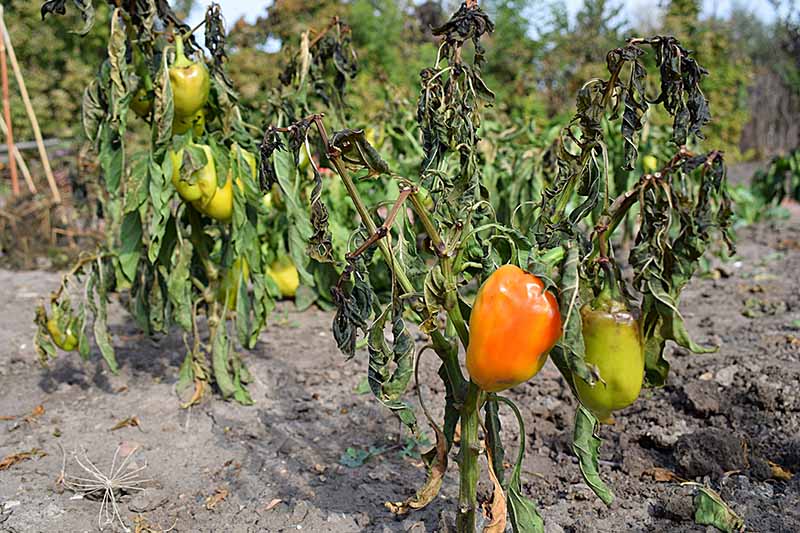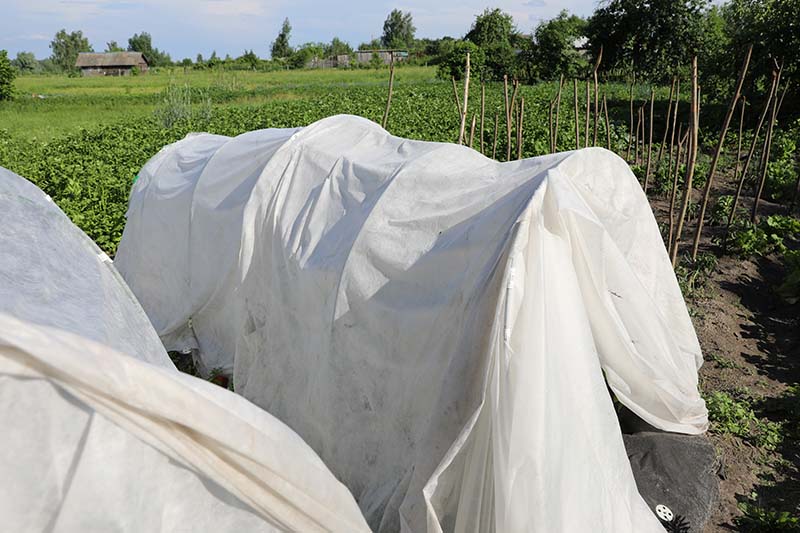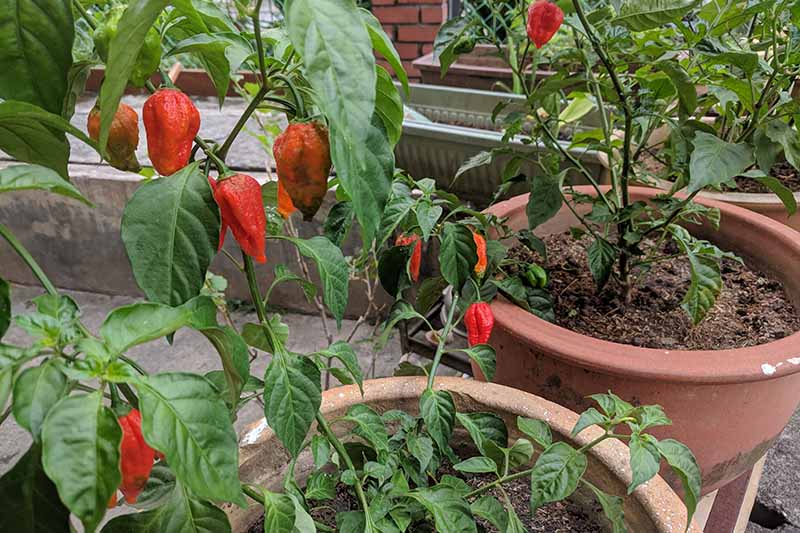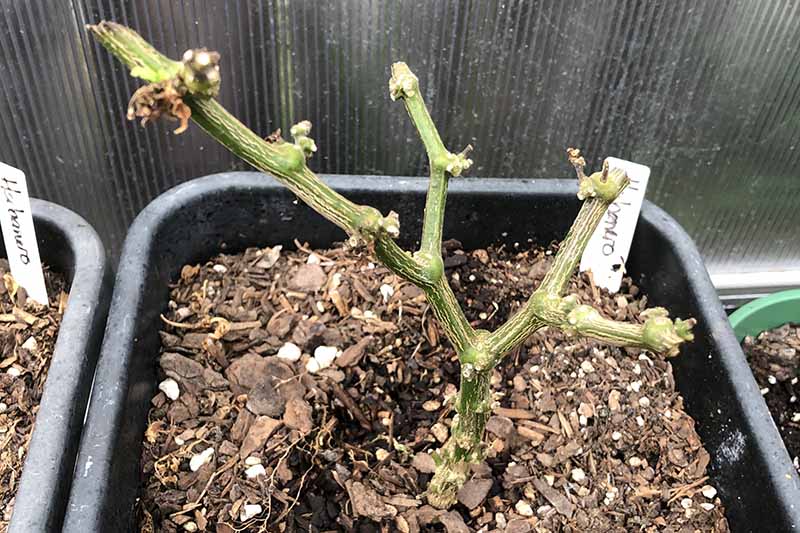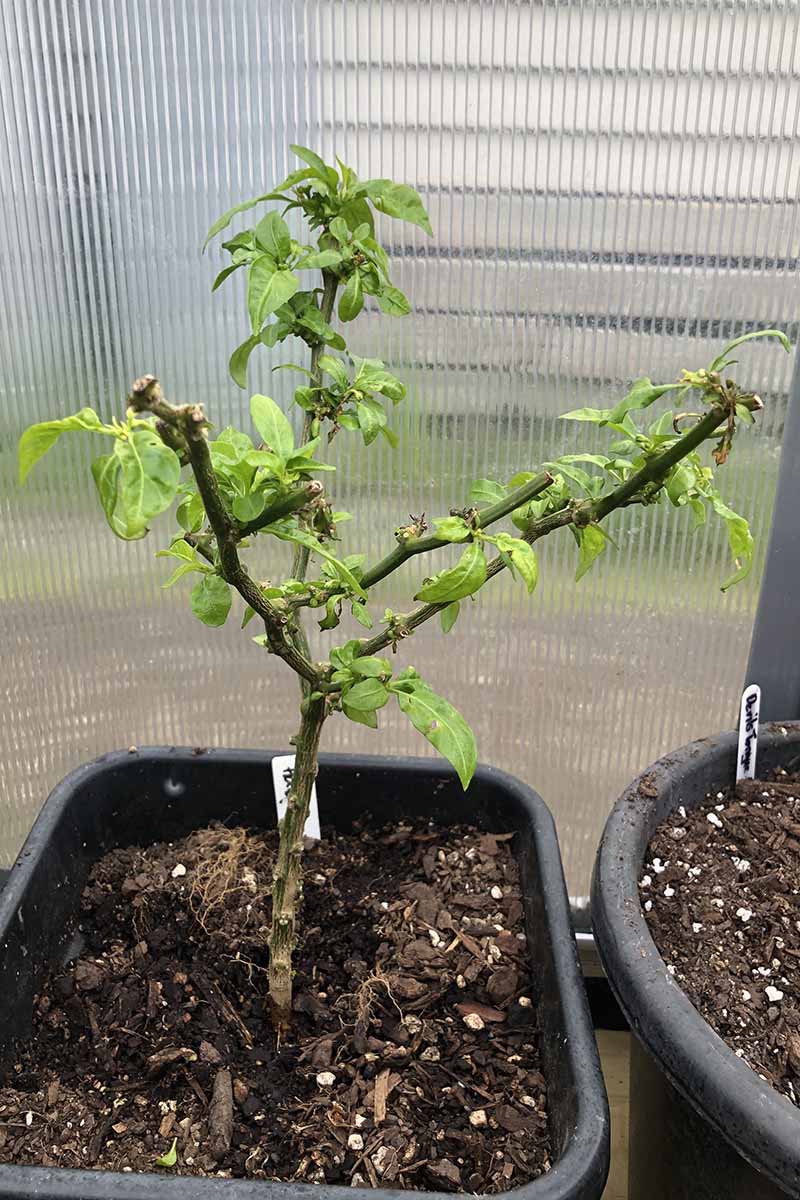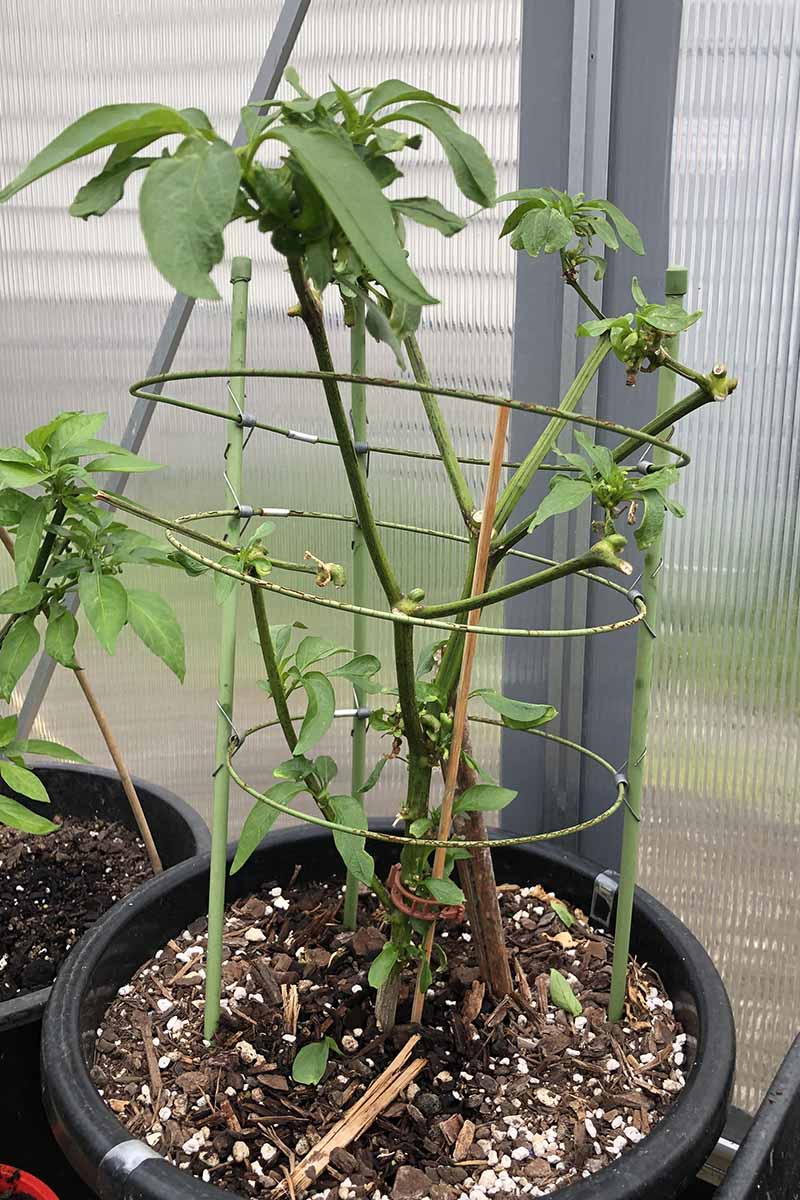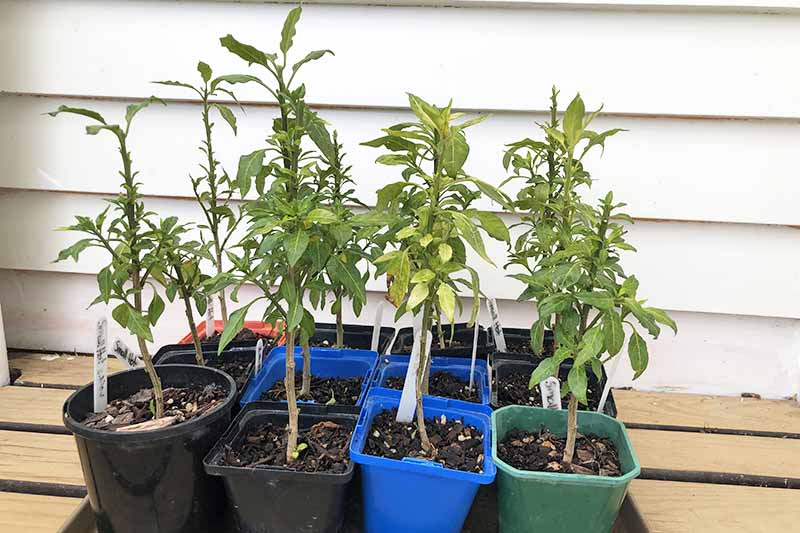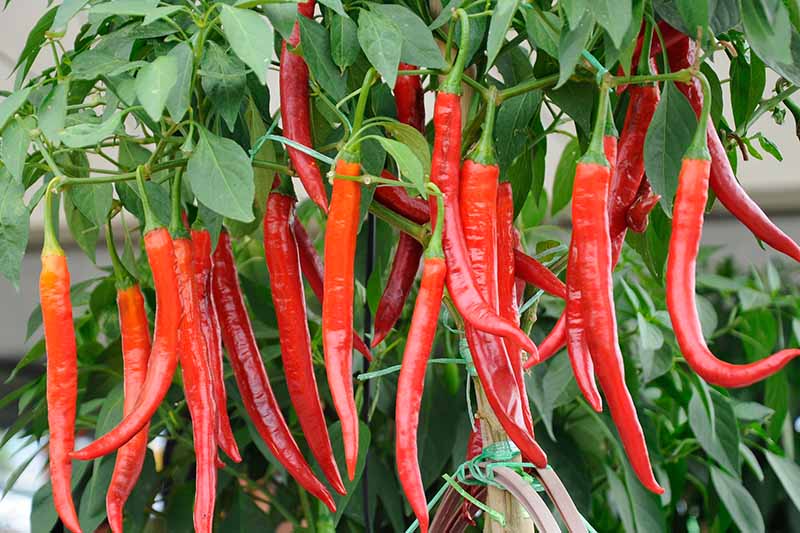Armed with a freezer full of more peppers than anyone can possibly eat, I’ll still miss the fresh taste of my homegrown crop. Many gardeners treat hot peppers as annuals, and simply start new ones from seed in the winter months, ready to set out when the weather warms up in spring. I used to do this, but over the years as my “pepper obsession” grew, so did my collection of unusual varieties. We link to vendors to help you find relevant products. If you buy from one of our links, we may earn a commission. Last season, I overwintered 38 hot peppers. Yes, I was a little bit surprised when I actually counted them. Some of them were small – ones I’d started too late and had only produced a modest amount of fruit. Others were in their fourth year of wintering-over. I’ll confess, I lost a few, which is to be expected. Hot peppers can be temperamental to grow, and one or two of the smaller ones simply failed to thrive. Another, a big, beautiful habanero, seemed to suffer and only produced small quantities of tiny fruit. He was old, so I thanked him for his service and put “big hab,” as I called him, onto the compost pile. He’d survived three Zone 9 winters, and I guess he’d just had enough. In this guide I’m going to walk you through how to prepare hot pepper plants for the winter, so if you’ve got a favorite growing this year, you can give it a try! Here’s what I’ll cover:
Why Overwinter Hot Peppers?
Hot peppers are tropical and subtropical perennial species in the Capsicum genus. They are frost-tender and when nighttime temperatures drop to below 60°F and the days become shorter they will start to go dormant and drop their leaves. Temperatures below 35°F will kill the plant.
In tropical gardens, it’s possible for plants to fruit year-round, when they are provided with the ample sunshine and warmth they require. In cooler locations, with a bit of preparation, we can let them go dormant for the winter months and in some cases, they’ll bounce back come spring, ready to fruit in the warm weather. I say “in some cases” because not all plants survive the overwintering process, for a variety of reasons. It may be that the plant was suffering from lack of nutrition during the growing season, or the temperature dipped a little bit too low – or perhaps it took offense to your pruning methods. Make sure you choose your strongest, healthiest looking specimens as weaker ones aren’t likely to survive. I’ve had good success with the majority of my hot peppers, but as mentioned, I expect to lose a few. Which is why from the middle of winter my grow tent is filled with a number of seedlings – and my electricity bill is suffering. With their mind-numbingly long growing season, it may come as a surprise that the “super hot” peppers seem to be more successful at overwintering than some of their less mind-blowing brethren. In my experience, jalapenos often don’t make it, but my favorite brain-melter, the ghost pepper, seems to come back flying and fruiting after a long day’s journey into the winter night. Would you like to try your hand at growing ghost peppers? If so, check out our growing guide to learn more. The main advantage of overwintering those long-season super-hots is that while you are waiting for seeds to germinate, for seedlings to develop their first true leaves, battling pests, and patiently hoping for a fruit to develop – your overwintered plants are out of the starting gates faster than Secretariat. Those that have wintered-over have strong root systems which allows them to get going with the serious business of reproduction much earlier than all those babies carefully tended in a grow tent – or on your windowsill, depending on how far your pepper obsession has progressed. I haven’t (yet?) got to the point where I keep my plants in artificial warmth and light so that they fruit year-round. That’s next-level obsession and I’d better have shares in the local electricity company first…
How to Prepare Your Hot Peppers for Winter
There are a few steps you need to take before you put your hot peppers to bed for the winter and they’ll require a little bit of maintenance over the cold months. If you’re growing your peppers in the ground, you’ll need to pot them up. In frost-free locations, your plants may be overwintered in place. If the word “frost” features in your climate, you’ll need to pot up your plants and bring them into your home – or a garage, shed, or greenhouse. Ideally, the temperature of your chosen location will remain between 50-60°F for the duration of the winter months. Your plants may survive if the temperature drops below this for a short period of time, but you’re heading into risky territory. If you choose to bring your plants into your home where the temperature is higher, it’s possible that they will not go completely dormant. In their semi-dormant state, you may find a little bit of slow growth throughout the colder months.
Pot Them Up
Hot peppers can be a bit bad-tempered about transplanting, so you’ll need to do this very carefully – and keep in mind that the stress of digging up and potting up might cause your overwintering efforts to come to naught.
In fall, before nighttime temperatures start to dip below 55-60°C, you’ll need to dig up your plants. At this point they may still have some ripe or unripe peppers. You can choose to do one final harvest before you dig it up or leave them on the plant to continue ripening before you prune and put it to bed. For best results, it’s very important to avoid damaging the root ball. Depending on the size of your plant, mark out a radius of four to six inches around the stem, and dig down six to eight inches. Gently lift the plant out of the ground and shake it lightly to dislodge any loose soil. Place in a clean pot that’s a bit larger than the size of the root ball. I like to use fresh, well-draining potting soil to fill around the root ball. Water in well, and move the pot to a sunny, sheltered spot for up to a week. Or if you’ve left it a bit late, and your plant has already dropped some of its foliage, you’ll want to prune as described below, and put it to bed in your chosen location.
Prune
When you’ve potted up your plants, or if you are already growing your peppers in containers, before you put them away for the winter and let them go dormant, you’ll need to give them a good pruning.
Before you get started, inspect your plants carefully for any signs of pest or disease issues. If you find whiteflies or aphids, give them a blast of water from the hose or a light dose of neem oil or insecticidal soap. Those suffering from signs of disease are not good candidates for overwintering. Remove any mulch from around the potted plants and check the soil for ants. You want to avoid bringing pests indoors for the winter. During the colder months, in their period of dormancy, the plants won’t be putting their energy into new growth and they will be ready to fire into action next spring. If the root system is healthy, your peppers can handle quite a severe pruning. To begin with, you’ll need to remove all the fruit from the plant – both ripe and unripe. In the past, I’ve brought plants laden with almost-ripe fruit into the house for two to three weeks to keep them warm and allow the fruit to finish ripening, but in the lower light environment, you’ll see the leaves start to yellow and drop. With my smaller plants – those that have one main stem and only very little branching, I prune them by two-thirds. For my larger plants, particularly those that have already been overwintered in the past, I give them a severe haircut. Right down to the first leaf node on each branching stem. You’ll notice that your pepper plants have a number of “V” shaped branches growing off the main stem. Your goal is to cut down the plant so that you have three to five “V” shapes left, depending on the size. Remove all the foliage. And then spend the next few hours worrying whether you have killed your plant. Time will tell!
To Repot or Not?
Some pepper growers like to repot their plants at the same time as pruning. I don’t typically do this, but I’m diligent about repotting during the growing season, before the plants set fruit. This past season I did an experiment in which I repotted one of my smaller specimens just after pruning. It survived the winter quite happily and gave me roughly the same harvest as the other small guys who I repotted as I usually do – in spring – after new growth has started to appear. The way I have had success is to ensure that the plants are repotted as needed during the growing season so that by the time winter rolls around, they are already in a container of a suitable size.
Fertilize and Mulch
It may seem counterintuitive to apply fertilizer before overwintering, but I have found that a dose of slow-release balanced fertilizer such as 5-5-5 (NPK) can set them up for a good start come springtime. After you have finished pruning, apply granular fertilizer to the top of the soil in your container, and water in well. If desired, you can apply a new layer of mulch – chopped leaves, fine bark, or straw is ideal. Mulching helps to keep the roots a little bit warmer and prevents the soil from drying out completely.
Winter Care
Care of your plants during their dormancy couldn’t be easier. I place my pots in a shed that has a bit of natural light coming in through the windows and I check them once every two to three weeks, depending on how well my memory is working. They will require minimal water, but don’t allow the soil to dry out completely. I give mine water when the soil is dry to one or two inches down – depending on the size of the pot. If you have applied mulch, this may be once every three to four weeks – or more frequently. Keep an eye out for pests as well. I seem to have a particularly robust type of aphid inhabiting my outbuildings and even in the deepest of my Zone 9 winter I’ve given my plants a spray with neem oil or insecticidal soap to get rid of the little blighters. Gouevn Moisture Meter
Prepare for Spring
You’ve waited patiently through those cold winter months and your supply of dried and frozen peppers is dwindling, so what now? As the temperatures start to warm up in early spring you can move your pepper plants to a location with more light – or put them under a grow light. As they are exposed to longer days, you should see some signs of new growth. Be patient, they can be a little slow to wake up. What I do is to move my plants out of the shed and into a protected, warm location on my deck for a few hours a day. The goal is that they are exposed to warmer daytime temperatures and more light, but you don’t want to make the mistake of leaving them out overnight. Alternatively, if you were overwintering your plants on a windowsill in your home, they’ll naturally be exposed to more light. As soon as you see signs of new growth, you can gradually start to increase your watering. If you applied fertilizer before dormancy, the plants should have everything they need to get a good jump on the growing season. If not, you can start your regular fertilizing schedule. Learn more about how to fertilize hot peppers in our guide. (coming soon!) After all risk of frost has passed, you can gradually harden them off in a protected location, over the course of a week, before setting them outdoors permanently. Be careful of late cold snaps which can wreak havoc with the new growth. Keep them in a location where they will be protected from any sudden temperature changes or consider moving them indoors or covering with a frost cloth overnight.
Feel the Heat Year after Year
For the past few years, I maintained that I was growing “a few” hot peppers and in certain circumstances I’d admit to having “several.” At last count, I have 87 plants at various stages of maturity. Some are tiny just-germinated seedlings still in their seed flats.
Others are big, healthy seedlings waiting for the warm weather so that they can start to flower. And then there are my overwintered ones, those stalwarts of seasons gone. I hate to say goodbye to my peppers as the summer gives way to fall – but it’s inevitable that even with the best care, not all my plants will come back next year. Those that do, typically provide me with a gloriously abundant harvest, topping up my dwindling supply earlier than the baby plants I’ve tended through the spring. Have you overwintered your hot pepper plants? Are you inspired to try? Let me know in the comments below! And for more information about growing peppers, check out these guides next:
How to Plant and Grow Serrano Peppers Grow Crunchy, Sweet Bell Peppers in Your Backyard How to Grow Ornamental Peppers
Photos by Clare Groom © Ask the Experts, LLC. ALL RIGHTS RESERVED. See our TOS for more details. Uncredited photos: Shutterstock.
